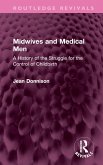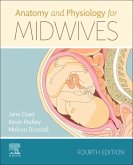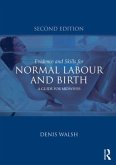The Anatomy and Physiology Textbook for Midwives
Herausgeber: Carpenter, Jane; Hunter, Louise
The Anatomy and Physiology Textbook for Midwives
Herausgeber: Carpenter, Jane; Hunter, Louise
- Broschiertes Buch
- Merkliste
- Auf die Merkliste
- Bewerten Bewerten
- Teilen
- Produkt teilen
- Produkterinnerung
- Produkterinnerung
Focusing on optimising the normal biological processes of reproduction and early life, and in line with the NMC Future Midwives Standards, this comprehensive textbook introduces the fundamental anatomy and physiology knowledge needed for midwifery practice.
Andere Kunden interessierten sich auch für
![Midwifery Midwifery]() Helen Baston (UK University of Sheffield)Midwifery123,99 €
Helen Baston (UK University of Sheffield)Midwifery123,99 €![Preterm Birth Preterm Birth]() Naomi CarlislePreterm Birth55,99 €
Naomi CarlislePreterm Birth55,99 €![Midwives and Medical Men Midwives and Medical Men]() Jean DonnisonMidwives and Medical Men98,99 €
Jean DonnisonMidwives and Medical Men98,99 €![Anatomy And Physiology For Midwives Anatomy And Physiology For Midwives]() Jane Coad (Professor in Nutrition, Massey University, Palmerston NoAnatomy And Physiology For Midwives36,99 €
Jane Coad (Professor in Nutrition, Massey University, Palmerston NoAnatomy And Physiology For Midwives36,99 €![Law and Ethics for Midwifery Law and Ethics for Midwifery]() Elinor ClarkeLaw and Ethics for Midwifery173,99 €
Elinor ClarkeLaw and Ethics for Midwifery173,99 €![Law and Ethics for Midwifery Law and Ethics for Midwifery]() Elinor ClarkeLaw and Ethics for Midwifery49,99 €
Elinor ClarkeLaw and Ethics for Midwifery49,99 €![Evidence and Skills for Normal Labour and Birth Evidence and Skills for Normal Labour and Birth]() Evidence and Skills for Normal Labour and Birth69,99 €
Evidence and Skills for Normal Labour and Birth69,99 €-
-
-
Focusing on optimising the normal biological processes of reproduction and early life, and in line with the NMC Future Midwives Standards, this comprehensive textbook introduces the fundamental anatomy and physiology knowledge needed for midwifery practice.
Produktdetails
- Produktdetails
- Verlag: Taylor & Francis Ltd
- Seitenzahl: 390
- Erscheinungstermin: 24. März 2025
- Englisch
- Abmessung: 246mm x 174mm x 21mm
- Gewicht: 790g
- ISBN-13: 9781032130842
- ISBN-10: 1032130849
- Artikelnr.: 70771281
- Herstellerkennzeichnung
- Libri GmbH
- Europaallee 1
- 36244 Bad Hersfeld
- gpsr@libri.de
- Verlag: Taylor & Francis Ltd
- Seitenzahl: 390
- Erscheinungstermin: 24. März 2025
- Englisch
- Abmessung: 246mm x 174mm x 21mm
- Gewicht: 790g
- ISBN-13: 9781032130842
- ISBN-10: 1032130849
- Artikelnr.: 70771281
- Herstellerkennzeichnung
- Libri GmbH
- Europaallee 1
- 36244 Bad Hersfeld
- gpsr@libri.de
Jane Carpenter initially studied biology at BSc, MRes and DPhil level. She then completed her midwifery education. Jane is now Lead Midwife for Education at Oxford Brookes University, with a passion for midwifery education and midwifery research. She also maintains her lifelong love of biology, and more specifically, for all things anatomy and physiology in childbearing related. Louise Hunter is a midwife and midwifery educator with a keen interest in inclusivity and lactation. A former Lead Midwife for Education, she is now an examiner for the NMC Test of Competence and a Breastfeeding Supporter for the Breastfeeding Network.
Foreword
Section 1: The Foundations for Life
1.1: The Human Cell
1.2: Tissues
1.3: Homeostasis
Section 2: Reproduction and Fetal Development
2.1: Mitosis and Meiosis
2.2: Genetics, Genetic Disorders and Epigenetics
2.3: Male and Female Reproductive Systems
2.4: Reproduction and Embryology
2.5: The Placenta and Developing Fetus
Section 3: Maternal Changes and Adaptations to Pregnancy
Chapter 3.1: The Blood and Cardiovascular System
Chapter 3.2: The Respiratory System
Chapter 3.3: The Nervous System
Chapter 3.4: The Endocrine System
Chapter 3.5: The Musculoskeletal System
Chapter 3.6: The Renal System
Chapter 3.7: The Gastrointestinal System
Chapter 3.8: The Immune System
Section 4: Labour and Birth
Chapter 4.1: The Maternal Pelvis
Chapter 4.2: Physiology of First Stage of Labour
Chapter 4.3: The Physiology of the Second Stage of Labour
Chapter 4.4: The Fetus during Labour
Chapter 4.5: The Third Stage of Labour
Chapter 4.6: Pelvic Floor and Perineum
Chapter 4.7: Changes to Body Systems in Labour and Birth
Section 5: The Puerperium
Chapter 5.1: Maternal Postnatal Physiology
Chapter 5.2: The Transition from Fetal to Neonatal Life
Section 6: Lactation
Chapter 6.1: The Constituents of Breastmilk
Chapter 6.2: The Anatomy of the Breast and the Physiology of Lactation
Chapter 6.3: Supporting and Maintaining Breastfeeding
Section 1: The Foundations for Life
1.1: The Human Cell
1.2: Tissues
1.3: Homeostasis
Section 2: Reproduction and Fetal Development
2.1: Mitosis and Meiosis
2.2: Genetics, Genetic Disorders and Epigenetics
2.3: Male and Female Reproductive Systems
2.4: Reproduction and Embryology
2.5: The Placenta and Developing Fetus
Section 3: Maternal Changes and Adaptations to Pregnancy
Chapter 3.1: The Blood and Cardiovascular System
Chapter 3.2: The Respiratory System
Chapter 3.3: The Nervous System
Chapter 3.4: The Endocrine System
Chapter 3.5: The Musculoskeletal System
Chapter 3.6: The Renal System
Chapter 3.7: The Gastrointestinal System
Chapter 3.8: The Immune System
Section 4: Labour and Birth
Chapter 4.1: The Maternal Pelvis
Chapter 4.2: Physiology of First Stage of Labour
Chapter 4.3: The Physiology of the Second Stage of Labour
Chapter 4.4: The Fetus during Labour
Chapter 4.5: The Third Stage of Labour
Chapter 4.6: Pelvic Floor and Perineum
Chapter 4.7: Changes to Body Systems in Labour and Birth
Section 5: The Puerperium
Chapter 5.1: Maternal Postnatal Physiology
Chapter 5.2: The Transition from Fetal to Neonatal Life
Section 6: Lactation
Chapter 6.1: The Constituents of Breastmilk
Chapter 6.2: The Anatomy of the Breast and the Physiology of Lactation
Chapter 6.3: Supporting and Maintaining Breastfeeding
Foreword
Section 1: The Foundations for Life
1.1: The Human Cell
1.2: Tissues
1.3: Homeostasis
Section 2: Reproduction and Fetal Development
2.1: Mitosis and Meiosis
2.2: Genetics, Genetic Disorders and Epigenetics
2.3: Male and Female Reproductive Systems
2.4: Reproduction and Embryology
2.5: The Placenta and Developing Fetus
Section 3: Maternal Changes and Adaptations to Pregnancy
Chapter 3.1: The Blood and Cardiovascular System
Chapter 3.2: The Respiratory System
Chapter 3.3: The Nervous System
Chapter 3.4: The Endocrine System
Chapter 3.5: The Musculoskeletal System
Chapter 3.6: The Renal System
Chapter 3.7: The Gastrointestinal System
Chapter 3.8: The Immune System
Section 4: Labour and Birth
Chapter 4.1: The Maternal Pelvis
Chapter 4.2: Physiology of First Stage of Labour
Chapter 4.3: The Physiology of the Second Stage of Labour
Chapter 4.4: The Fetus during Labour
Chapter 4.5: The Third Stage of Labour
Chapter 4.6: Pelvic Floor and Perineum
Chapter 4.7: Changes to Body Systems in Labour and Birth
Section 5: The Puerperium
Chapter 5.1: Maternal Postnatal Physiology
Chapter 5.2: The Transition from Fetal to Neonatal Life
Section 6: Lactation
Chapter 6.1: The Constituents of Breastmilk
Chapter 6.2: The Anatomy of the Breast and the Physiology of Lactation
Chapter 6.3: Supporting and Maintaining Breastfeeding
Section 1: The Foundations for Life
1.1: The Human Cell
1.2: Tissues
1.3: Homeostasis
Section 2: Reproduction and Fetal Development
2.1: Mitosis and Meiosis
2.2: Genetics, Genetic Disorders and Epigenetics
2.3: Male and Female Reproductive Systems
2.4: Reproduction and Embryology
2.5: The Placenta and Developing Fetus
Section 3: Maternal Changes and Adaptations to Pregnancy
Chapter 3.1: The Blood and Cardiovascular System
Chapter 3.2: The Respiratory System
Chapter 3.3: The Nervous System
Chapter 3.4: The Endocrine System
Chapter 3.5: The Musculoskeletal System
Chapter 3.6: The Renal System
Chapter 3.7: The Gastrointestinal System
Chapter 3.8: The Immune System
Section 4: Labour and Birth
Chapter 4.1: The Maternal Pelvis
Chapter 4.2: Physiology of First Stage of Labour
Chapter 4.3: The Physiology of the Second Stage of Labour
Chapter 4.4: The Fetus during Labour
Chapter 4.5: The Third Stage of Labour
Chapter 4.6: Pelvic Floor and Perineum
Chapter 4.7: Changes to Body Systems in Labour and Birth
Section 5: The Puerperium
Chapter 5.1: Maternal Postnatal Physiology
Chapter 5.2: The Transition from Fetal to Neonatal Life
Section 6: Lactation
Chapter 6.1: The Constituents of Breastmilk
Chapter 6.2: The Anatomy of the Breast and the Physiology of Lactation
Chapter 6.3: Supporting and Maintaining Breastfeeding









